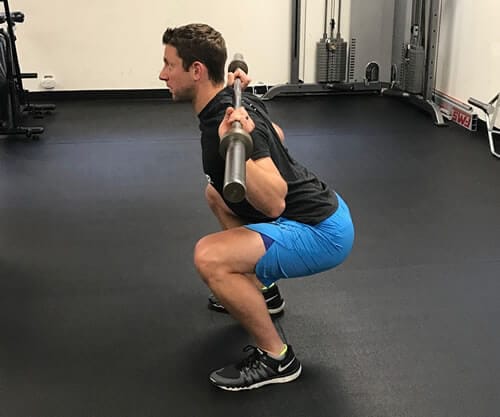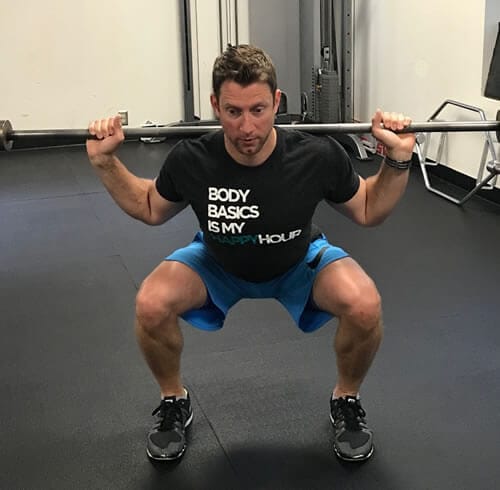
At our personal training studio, Body Basics, we have almost all of our clients do some variation of a squat. This might be a barbell front squat (for the high performers), a kettlebell sumo squat, a stability ball squat against the wall, or a high bench sit-to-stand for others. Regardless of age or athletic ability, we all need to be able to squat. It’s one of the most fundamental movements, and it is what we do every day getting up and down out of a chair or when picking something up. In that case, how do you know if you’re squatting correctly to prevent injury? Below are a few tips on performing a squat correctly.
‘Do not let you knees go past your toes when in the squat position’ is one basic rule most of you probably know, but there is quite a bit more to it than that. If the factors I list below are correct, then the knees and toes will take care of themselves.
Here’s what I pay attention to when assessing someone’s squat (or mine):
- Is the weight equally balanced over the feet?
- Are the hips, knees and ankles aligned correctly (front view)?
- Are the hips engaged (i.e. glutes working and firing)?
- Is the spine neutral with the chest lifted?
Here’s how that looks in practice.

Notice, my back is flat (i.e. neutral spine), my hips are engaged (i.e. my butt muscles are firing), my weight is evenly distributed over my feet, and the load (i.e. barbell) is centered over my feet. All these factors will lead to a good squat.
Notice, this picture is taken from the side to show the position of my hips, knees, back and feet. Here’s a picture from the front to show how my hips knees and ankles align. This is a commonly missed or neglected element of the squat.

Notice my feet are about shoulder width apart, my toes are pointed forward, and my feet track over my ankles. Side note: the position of the toes pointing outward or forward is completely dependent upon your hip structure and preference. There is no right or wrong here. Just pay attention to whether your knees are aligned over your ankles. Normally, when I do back squats, I point my toes out a bit. If your knees are tracking inside of your ankles and feet, you either lack mobility in your hips, or you need to adjust your stance. From this point, I’m watching to see if there is a straight line from your hip, through your knee to your ankle. The line through your hip, knees and ankle should be commensurate with the angle of your feet. Meaning, if your feet are angled out slightly, your line should be too. See picture below.

Depth of squat is a variable that indicates mobility and strength. No matter how far down you can go, keep your form intact. Don’t ever compromise your form to lift more weight or go down farther than you’re able. If you find elements of your form being compromised, work on your mobility or strength in the areas you’re weak. Pay attention to low and mid back strength. Look for more blogs on how to improve this in the future.
Pay attention to these factors and you’ll be on your way to squatting well!

